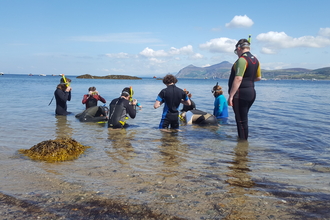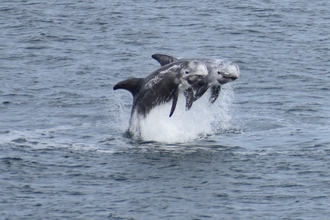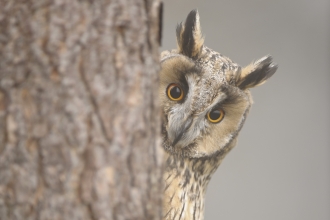If you would like to volunteer with the Seagrass Ocean Rescue Project follow the link below:
LATEST NEWS: Winter 2024
Project Update - Summer 2024
Project Update- A round up of 2023
Project Update - July 2023
We would like to share an update on the Seagrass Ocean Rescue North Wales project. After planting seagrass seeds at Y Gamlas and Penychain in February and April, we went back into the field at the start of June to see how the seagrass is doing. We were excited to find that many seeds have turned into seedlings at both locations, with the highest number of seedlings at Y Gamlas. These results give us an initial indication that the sites are ecologically suitable for seagrass to grow, which is excellent news. As we also planted seagrass seeds using different methods, we will conduct an in-depth analysis to see what worked best, as this will guide our future planting efforts. In the months to come, we will go back and monitor the seedlings again to see how well they fare over the summer, and whether they survive through the winter. But for now, we are very pleased with how they are doing.
The next step is to collect seagrass seeds at Porthdinllaen during 30th July – 11th August. If you would like to stop by and see our work in action, you are more than welcome to do so. Furthermore, we have volunteering opportunities coming up – please email volunteers@projectseagrass.org if you would like more information.
If you have any questions, please get in touch - we would love to hear from you.
Pen Llŷn a’r Sarnau SAC: Alison Palmer Hargrave (alisonpalmerhargrave@gwynedd.llyw.cymru)
North Wales Wildlife Trust: Nia Jones (Nia.Jones@northwaleswildlifetrust.org.uk)
Project Seagrass: Flo Taylor (flo@projectseagrass.org)
Project Update - April 2023
Now that spring has come, we would like to share a brief update on the Seagrass Ocean Rescue project to restore seagrass in North Wales.
In February, we started the seagrass planting work and managed to plant 150,000 seagrass seeds on the south side of Pen Llŷn with the help of a team of volunteers - it was a great start to the project!
In April, we aim to plant another 50,000 seeds in the subtidal zone at Y Gamlas (also known as Carreg y Defaid) on Pen Llŷn during 14 and 15 April using SCUBA diving - see attached map. We already planted 50,000 seeds at Y Gamlas in February, yet that was higher on the shore.
Similarly to February, we will again plant small hessian bags filled with sand and seagrass seeds. Additionally, we will trial a new planting method, namely to put seeds inside small balls of natural clay and to bury these balls, which is a method that we previously trialed in our seagrass aquarium with promising results. It is the marine equivalent of seed bombs. Lastly, we will plant a few seagrass shoots that were raised in our aquarium in Swansea, which were grown from seeds collected at Porthdinllaen.
If you have any questions, please get in touch - we are happy to hear from you. Moreover, if you would like to visit us whilst we are in the field, we would be excited to meet you! In that case, please contact Project Seagrass.
Project Update - February 2023
As spring will soon be on our doorstep, we would like to share the upcoming plans of the Seagrass Ocean Rescue team to restore seagrass in North Wales. Furthermore, we wish to share with you our reasoning for selecting specific sites to start the restoration work.
Following extensive stakeholder engagement and ecological research a total of seven sites have been selected for further consideration, six on Pen Llŷn and one on Anglesey.
These sites have been selected after receiving input from local stakeholders and biological considerations. These include direct feedback from stakeholders via face-to-face discussions and online workshops, ecological knowledge provided by local community members, and discussions with relevant groups, organisations and site managers. We have also used information from our scientific surveys of the sites’ ecological conditions, scientific computer models that predict where seagrass could theoretically grow, and seagrass planting experiments in early 2022.
At the end of January, we undertook further site assessments to identify the best locations to start planting seagrass in February; we assessed sites by looking at e.g. the presence of living animals, algae, the types of habitats, sediment types, and the morphology of the coast. Based on these results, we will start planting seagrass seeds at three small plots: two at Pen-Ychain 1, and one at Y Gamlas.
After planting seagrass seeds in February, we will monitor the sites to see whether seagrass grows and establishes. Later this year, we hope to also plant mature plants in the field for the first time, which originate either from healthy meadows nearby, or from the Project Seagrass seagrass nursery in Carmarthenshire.
Overall, during 2023 we will focus our efforts on Pen Llŷn, which eases the logistics of our activities. In 2024, we will start planting seagrass on Anglesey, likely at Traeth Yr Ora.
When restoring seagrass ecosystems, it is essential to learn from your restoration activities and experiences, to integrate input from stakeholders, and to adapt and optimise the restoration strategy accordingly to successfully restore the seagrass. That is why, depending on the results of this year’s planting activities on Pen Llŷn, we may (i) increase our planting efforts at these sites in 2024 and later years, (ii) attempt seagrass restoration at one or multiple of the other sites, or (iii) continue our planting efforts at these sites and include other sites.
In total, we want to plant 10 hectares of seagrass across North Wales. However, the selected sites add up to more than 10 hectares. That is an important part of our approach to restoration: the selected sites are so-called seagrass search areas. They are larger than 10 hectares in total, because this approach gives us flexibility to find specific locations in these seagrass search areas where we have (i) the support of local communities to restore seagrass and (ii) ecological conditions that are suitable for seagrass to grow. Depending on ecological conditions and the support of local communities, this may mean that we end up planting at one, a few, or at all sites. Our coasts and seas are much less well known than the land, which requires us to be flexible in finding the right locations for seagrass restoration.
We hope that this provides you with an overview of the upcoming activities. If you have any questions, feedback, input, suggestions, or anything else, we will be happy to hear from you. You can reach us by contacting reece.halstead@northwaleswildlifetrust.org.uk
Seagrass Search Area Map
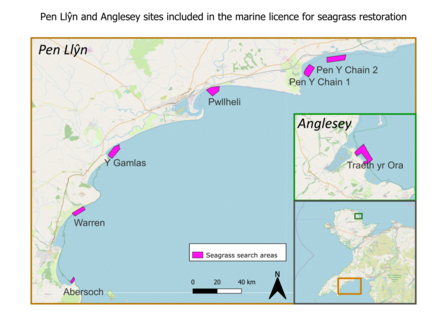
Seagrass Search Areas / Ardaloedd Archwilio Morwellt 2023 © Project Seagrass
Frequently Asked Questions
Seagrass Ocean Rescue FAQ
Mighty Meadows
The UK has lost up to 90% of its seagrass meadows in the past century, which has had negative consequences for the health and resilience of our coastal systems. In 2019, Swansea University, the charity Project Seagrass and WWF-UK formed a collaboration to begin to restore some of what we have lost. Concurrently, over the last six years Swansea University has been leading trials across Wales to develop appropriate methods for seagrass restoration.
Here in North Wales, we've now teamed up with the partnership to start exploring how we can bring this exciting project to North Wales. Funding secured from the National Lottery Heritage Fund will help us to deliver a socially agreeable and ecologically sound programme of restoration and we want you to get involved.
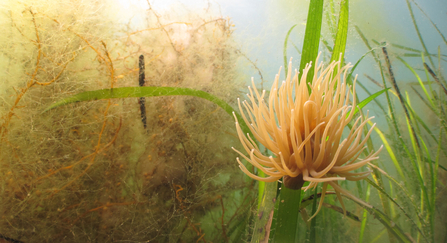
Snakelocks Anemone © Paul Naylor
The canary of the sea
Naturally, the extent and distribution of seagrass changes with seasonal and annual cycles. Physical disturbance in the form of the occasional storm may help keep it healthy and productive, but persistent disturbance and added human pressures have taken their toll. In the 1930s a significant proportion of seagrass in the UK died from a wasting disease, which attacks the leaves and prevents photosynthesis, killing the plant. With added human impact it is estimated that we have lost 92% of our seagrass in the last century. Researchers have dubbed seagrass beds the canaries of the sea — they reflect the general health of our oceans and human impact is becoming increasingly clear.
Estimates show that one hectare of healthy seagrass can support up to 80,000 fish and 100,000,000 invertebrates
The threats are varied. Nutrient run-off is a double-whammy: whilst toxic to seagrass it also stimulates growth in algae which competes with the seagrass for space and light. Invasive alien species also compete with seagrass and, in many places, it’s a competition they’re winning. Coastal development creates sediment that smothers the beds and damage by anchor chains, moorings, propellers and launching vehicles is also evident where boating activity is prevalent. Even trampling by coast users can be an issue at low tide.
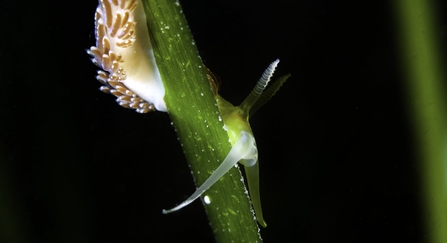
A colourful nudibranch (Facelina auriculata) searching for its food of small hydroids by climbing on a blade of seagrass (eelgrass: Zostera marina) meadow. Helford Estuary, Cornwall, England, British Isles. - Alexander Mustard/2020VISION
Blue Carbon
By losing seagrass we also lose the diversity of species that live there. But there’s even more at stake. Seagrass beds provide a whole host of essential ecosystem services. They filter pollutants, cycle nutrients, stabilise sediments and reduce coastal erosion. They also absorb huge amounts of carbon and because of this are increasingly recognised in the attempt to tackle the climate crisis and are considered an important natural solution. Seagrass beds sequester carbon — known as ‘blue carbon’ — in two ways: through photosynthesis and by trapping and stabilising particles from the water column. If undisturbed, carbon can be locked into seagrass sediments for millennia. It is therefore incredibly important that this special habitat is protected.
Globally, even though seagrass occupies only 0.1% of the seafloor, it accounts for between 10-18% of its annual carbon storage
Luckily seagrass is resilient and given the chance can recover. Whilst habitat management is not easy in the sea it is possible! Seagrass restoration projects are collecting seeds ready for replanting to create new meadows. Other work includes looking at mooring systems that reduce the physical impact of boating and educating people around the importance of seagrass. Whilst these meadows may remain unseen by many, they have a crucial role in bringing about nature’s recovery in the sea.
Restoration sites are yet to be finalised, To find out more about this project or to let us know what you think please contact our Living Seas Manager, Nia at nia.jones@northwaleswildlifetrust.org.uk

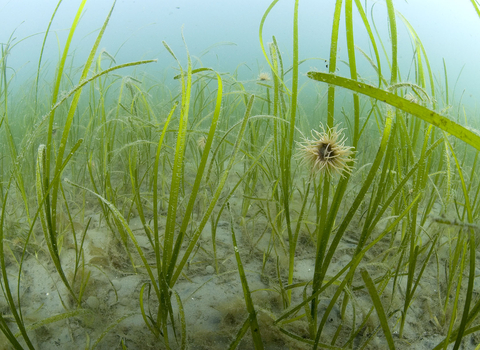
© Paul Naylor
Seagrass
Meadows of seagrass spread across the seabed, their dense green leaves sheltering a wealth of wildlife.
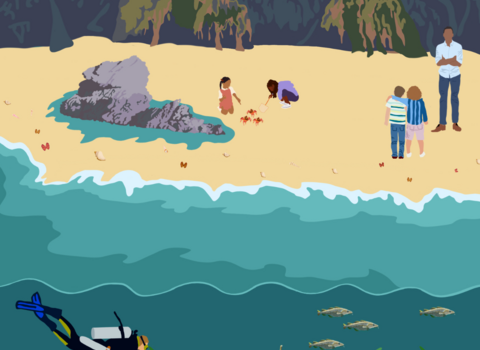
Seagrass and Me! © Project Seagrass
Seagrass and Me
Our friends at Project Seagrass have created a brilliant new Activity Pack for teachers, families and young people! If you're looking for some seagrass-themed fun click on the link below....

National Lottery Heritage Fund

